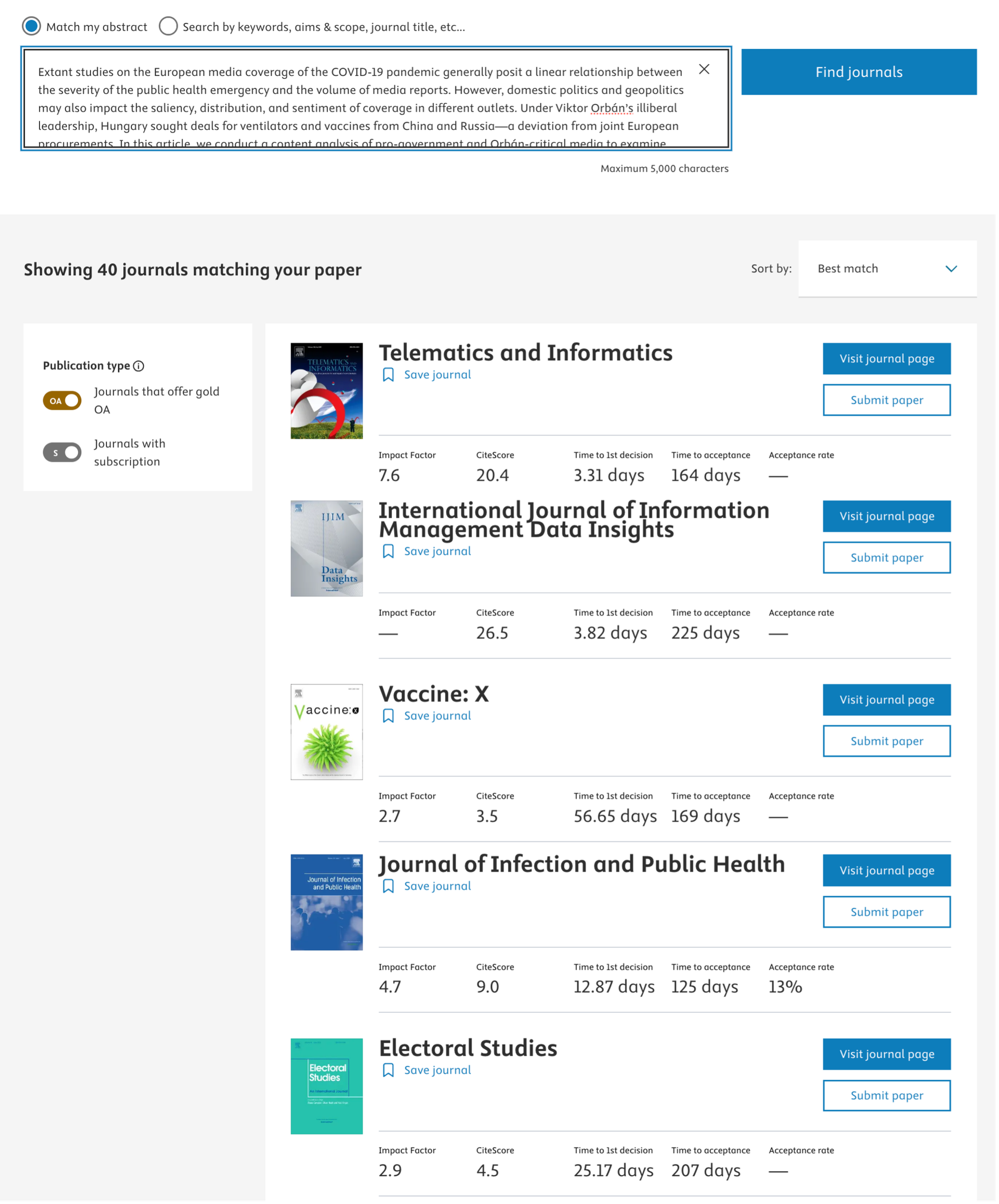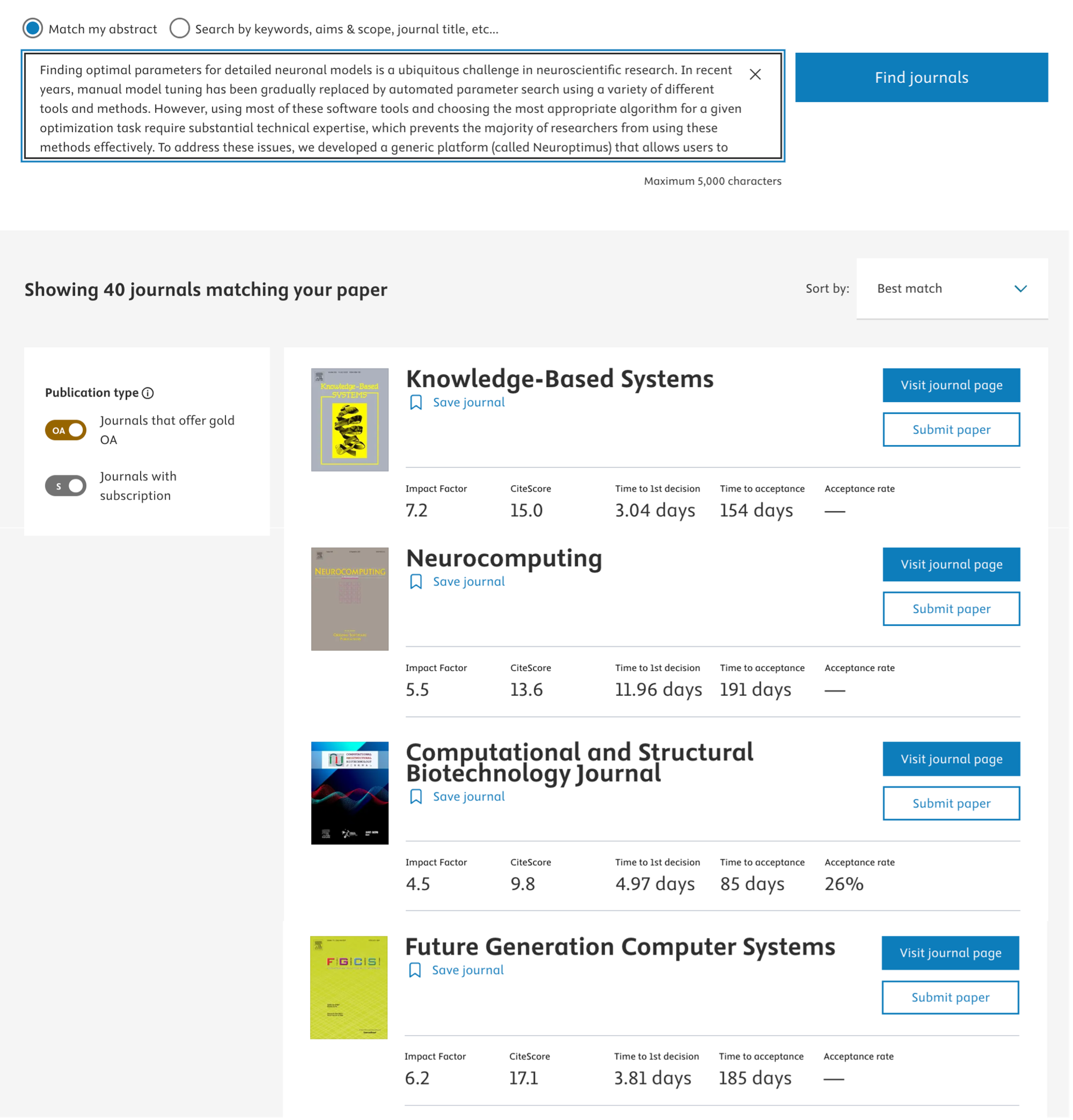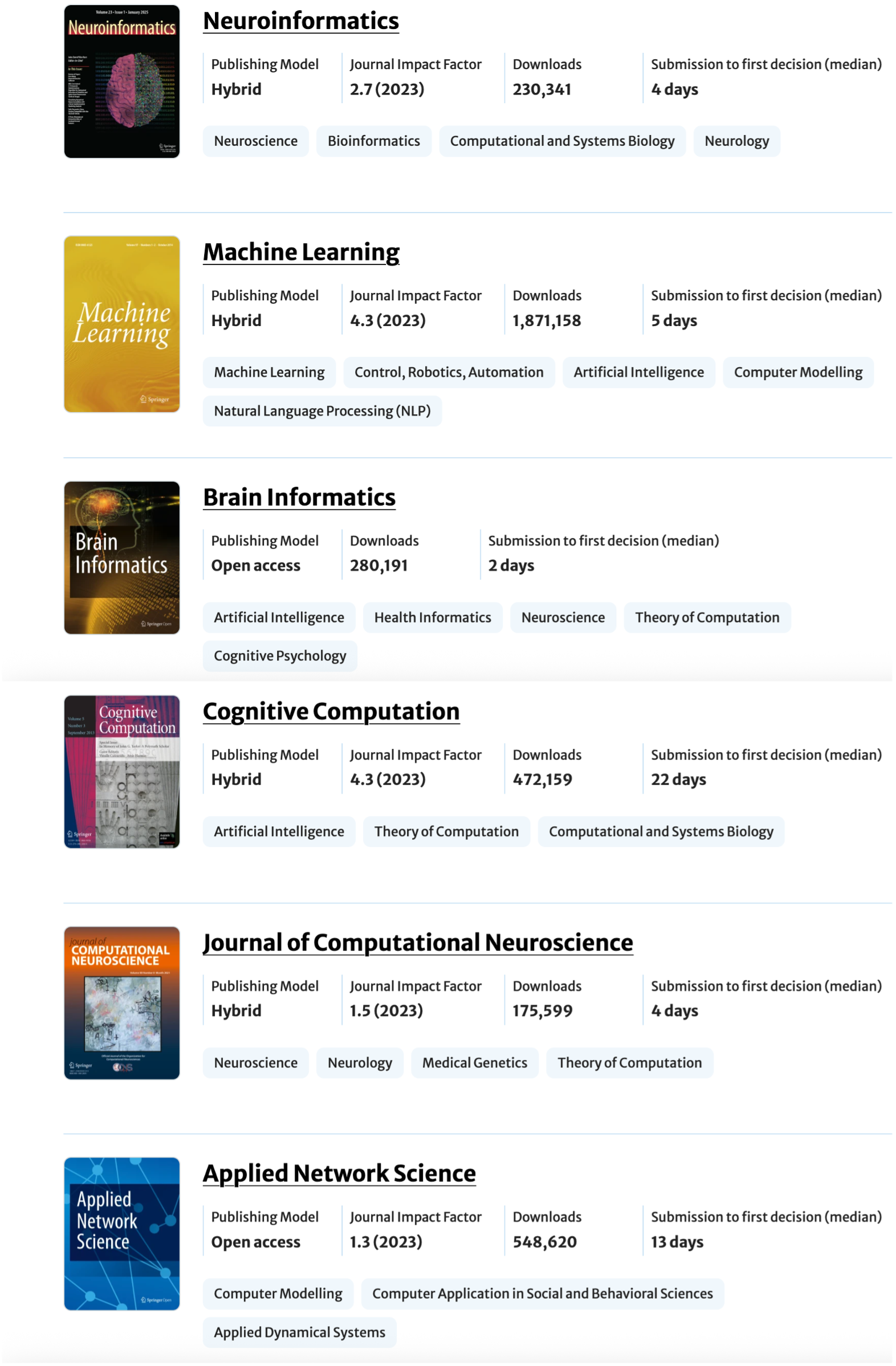As AI-assisted tools become increasingly embedded in academic publishing, most major journal platforms now offer automated systems that claim to recommend suitable outlets based on a manuscript’s abstract. But how well do these tools perform in practice? To explore this, we tested five journal finder platforms — four developed by major academic publishers (Elsevier, Springer, Wiley, and Taylor & Francis) — using three abstracts from the fields of legal studies, computational social science, and neuroscience. We aimed to assess whether these systems can identify relevant journals across domains, offer transparent editorial information, and adequately handle thematic and methodological complexity. This post presents a comparative evaluation of their performance, highlighting both the underlying selection logic and the structural limitations of automated journal recommendation systems.
Abstracts Used for Testing
To ensure a meaningful and varied evaluation of the journal finder tools, we selected three peer-reviewed abstracts from recent publications across different disciplines and research approaches. These abstracts served as input for all platforms tested.
- Legal and policy studies
A conceptual and empirical analysis of “legislative basket cases” — laws adopted under illiberal governance that systematically violate established quality standards in the policy cycle, public administration, and constitutional law. (Kiss, R., & Sebők, M. (2025). The (worst) laws of the land: the concept of legislative basket cases, legislative backsliding and public administration in Central-Eastern Europe. Policy Studies, 1–27.) - Computational social science
A sentiment analysis of Hungarian media narratives around COVID-19 vaccines, combining political communication research with deep learning methods (fine-tuned BERT) applied to a large corpus of news articles. (Sebők, M., Ring, O., Kis, M. G., Bánóczy, M. B., & Dinnyés, Á. (2024). The geopolitics of vaccine media representation in Orbán’s Hungary—an AI-supported sentiment analysis. Journal of Computational Social Science, 7(3), 2897-2920.) - Neuroscience and software engineering
A technical benchmarking study comparing over twenty parameter optimisation algorithms for neural modelling tasks, conducted with a custom-developed software framework and targeting high-performance computing applications. (Mohácsi, M., Török, M. P., Sáray, S., Tar, L., Farkas, G., & Káli, S. (2024). Evaluation and comparison of methods for neuronal parameter optimization using the Neuroptimus software framework. PLOS Computational Biology, 20(12), e1012039.)
Elsevier
Elsevier Journal Finder is a free, AI-powered tool designed to help researchers identify suitable Elsevier journals by analysing their manuscript abstract, keywords, title, or aims & scope. Leveraging the extensive Scopus index, it evaluates over 2,500 peer-reviewed journals, matching content using natural language processing and machine learning techniques.
Users can search in two distinct ways: (1) by entering their full abstract using the “Match my abstract” mode, or (2) by typing keywords, journal titles, or aims & scope phrases under “Search by keywords, aims & scope, journal title, etc.”. Both options return a ranked list of Elsevier journals based on semantic similarity and metadata. In our evaluation, we tested both input modes with all three abstracts to assess how consistently the tool recognises relevance and disciplinary fit.
Match my abstract mode
In abstract-based mode, Elsevier Journal Finder uses natural language processing to identify relevant journals based on semantic similarity. In principle, this should allow it to recognise complex thematic structures. In practice, however, the results proved inconsistent and difficult to interpret. Submitting the same abstract via different browsers led to notably different journal suggestions — a surprising outcome that points to potential sensitivity in the system’s ranking process, influenced by seemingly minor technical differences.
For instance, when we submitted the abstract of a paper on legislative quality and democratic backsliding in Central-Eastern Europe, one of the top suggestions was Women's Studies International Forum — a poor thematic fit. In another test, the system returned Social Science and Medicine as a top result, most likely due to a health-related case study on the Medical Chamber Law, rather than any recognition of the article’s overall legal-political focus.


The second abstract, which examined media narratives around vaccines, also yielded ambiguous matches. While Vaccine: X appears superficially relevant, the journal’s scope emphasises clinical and biomedical vaccine research. Despite its social science sub-focus, the match overstates compatibility. Similarly, Telematics and Informatics, an interdisciplinary journal focused on digital technology’s societal impacts, might only partially overlap with the article’s actual focus on sentiment analysis and geopolitics.

The third abstract, focused on neural parameter optimisation in neuroscience, produced somewhat more plausible matches. Journals like Neurocomputing or Computational and Structural Biotechnology Journal aligned reasonably with the article’s content. Yet even here, some top-ranked suggestions — such as Knowledge-Based Systems — seemed driven by keyword matching (e.g. “optimisation”, “systems”) rather than a robust thematic understanding of the submission.

Search by keywords, aims & scope, journal title, etc. mode
We also tested the keyword-based search mode, where instead of pasting an abstract, we entered three straightforward but thematically clear keywords (e.g. “public administration”, “democratic backsliding”, “legislative quality”). Surprisingly, this yielded no results at all — despite none of the terms being especially technical or narrowly defined.

When we reduced the search to a single keyword (“public administration”), the tool did return results, but their relevance remained questionable. Among the top matches were journals focused on healthcare and innovation technologies, with little apparent connection to the field of public administration.

Springer
Springer Journal Finder is a free online tool designed to help researchers identify suitable Springer journals for their manuscripts. Users can input either a full manuscript title, abstract, or a set of keywords to generate suggestions. The tool draws on Springer’s extensive portfolio of journals across disciplines and provides metadata such as impact factor, publishing model (hybrid or open access), decision times, and subject tags for each suggested outlet.
Abstract-based search function
When testing the abstract-based search function of Springer Journal Suggester, the results were markedly more relevant than those produced by Elsevier. For the first abstract — a study on legislative quality and democratic backsliding in Central-Eastern Europe — the suggested journals included Comparative European Politics and the Hague Journal on the Rule of Law. These are highly appropriate matches in terms of disciplinary focus and regional scope, and in fact, one of our related articles was published in one of the recommended outlets.

Similarly, for the third abstract — centred on neuroscientific parameter optimisation using AI tools — the tool returned journals such as Neurocomputing, Brain Informatics, and Neuroinformatics. While these vary slightly in technical emphasis, all are broadly aligned with the subject matter and methodology of the paper.

Title and keyword-based matching
When using Springer’s journal suggester tool in title or keyword mode, the results proved notably less convincing than in the abstract-based tests. Submitting the title “The geopolitics of vaccine media representation in Orbán’s Hungary – an AI-supported sentiment analysis” produced suggestions such as AI & Society and AI and Ethics. While these journals may align with certain methodological aspects of the paper (such as the use of artificial intelligence), they fall short in addressing the core empirical and geopolitical focus of the study.

Similarly, the keyword-based search — tested with the terms “public administration, democratic backsliding, legislative quality” — did not return results that could be considered highly relevant from a disciplinary perspective. Although some journals in political science or public policy appeared, these lacked clear thematic proximity to the democratic governance and legislative performance issues central to the query.

Taylor & Francis
The Taylor & Francis Journal Suggester allows users to identify potentially suitable journals by submitting the abstract of their manuscript or a selection of keywords. The tool is designed to assist researchers in narrowing down relevant options across the publisher’s extensive portfolio. Suggested matches are based on textual similarity, with each result providing a direct link to the journal’s aims and scope, submission guidelines, and key metrics such as impact factor and average review time.
Abstract-based inputs
The results obtained using abstract-based input varied considerably across the three test cases. For the first abstract—on legislative practices and democratic backsliding in Central and Eastern Europe—the tool returned several relevant options. These included The Theory and Practice of Legislation and European Politics and Society, both of which align thematically with the legal-political scope of the article. However, even in this relatively successful case, the list also included less clearly related suggestions.

The second abstract, which focused on media coverage of vaccine politics, yielded journal suggestions that appeared disconnected from the topic. Although some titles dealt broadly with communication or public policy, the specific focus of the article—pandemic-related media framing and geopolitics—was not well reflected in the recommended outlets.

The third abstract—focused on neural parameter optimisation in computational neuroscience—returned suggestions that were clearly misaligned. The top recommendations included journals in statistics and graphical methods (Technometrics, Journal of Computational and Graphical Statistics), which, while methodologically adjacent, do not directly serve the neuroscientific or bioinformatics communities. This result suggests the tool may prioritise certain keywords (e.g., "optimisation" or "algorithm") without fully grasping the broader disciplinary context.

Keyword-based matching
To further evaluate the tool’s effectiveness, we conducted a search using a curated list of keywords drawn directly from a published article. These included: public administration, democratic backsliding, legislative quality, legislative backsliding, legislative basket cases, Central-Eastern Europe, and policy implementation. In this case, the Taylor & Francis Journal Suggester performed notably better. Among the top results was Policy Studies—the very journal in which the article had in fact been published—alongside several other plausible options such as East European Politics, The Journal of Legislative Studies, and Europe-Asia Studies. These journals align well with the regional and thematic scope of the article.
Wiley
Wiley’s Journal Finder enables authors to identify potentially suitable journals by entering their manuscript’s title and abstract. The tool analyses the text to suggest relevant journals from the Wiley portfolio and provides indicators such as “matching strength” and basic relevance metrics. In contrast to more open-ended or exploratory tools, Wiley’s platform is designed to assist with submission targeting by allowing users to browse suggested titles and directly compare editorial timelines, impact factors, and access models.
For the first abstract—on legislative backsliding and legal quality in Central-Eastern Europe—no results were returned.

In the second test, which dealt with vaccine-related media coverage, the system surfaced medical and virology journals that focused almost exclusively on clinical aspects, missing the geopolitical and media framing components entirely.

The third abstract, which centred on parameter optimisation in computational neuroscience, generated results in telecommunications and operational research—fields with little to no substantive overlap with the article's neuroscientific framing.

Recommendations
Journal finder tools can be a helpful starting point, particularly when researchers explore unfamiliar outlets or work in fields with clearly defined terminology. However, our comparison suggests that these tools are not yet reliable enough to replace a more deliberate, manual selection process. In most cases, browsing the Journal Citation Reports (Clarivate) by relevant subject categories and closely reviewing journal scopes remains the more dependable strategy. Some features—such as the keyword-based search in the Taylor & Francis suggester—can offer useful starting points, but the results often require critical interpretation. For now, AI-assisted journal recommenders should be seen as exploratory aids rather than definitive submission guides.
The authors used GPT-4o [OpenAI (2025), GPT-4o (accessed on 11 June 2025), Large language model (LLM), available at: https://openai.com] to generate the output.






